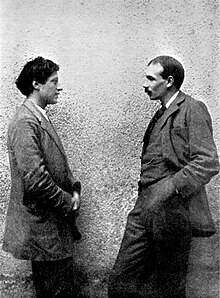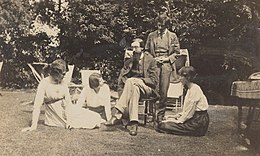Duncan Grant
Duncan Grant | |
|---|---|
National Gallery of Scotland | |
| Born | Duncan James Corrowr Grant 21 January 1885 Rothiemurchus, Aviemore, Inverness-shire, Scotland |
| Died | 8 May 1978 (aged 93) Aldermaston, Berkshire, England |
| Occupation(s) | Artist, designer |
| Known for | Member of the Bloomsbury Group |
| Partner(s) | Vanessa Bell Paul Roche |
Duncan James Corrowr Grant (21 January 1885 – 8 May 1978) was a Scottish painter and designer of textiles, pottery, theatre sets, and costumes. He was a member of the Bloomsbury Group.
His father was Bartle Grant, a "poverty-stricken" major in the army, and much of his early childhood was spent in
Early life
Childhood
Grant was born on 21 January 1885, to Major Bartle Grant and Ethel Isabel McNeil in
Art education and European influence
From about 1899/1900 to 1906, Grant lived with his aunt and uncle,
In the winter of 1904–5, Grant visited Italy where, commissioned by
Grant was introduced to
In January 1907, and again in the summer of 1908, Grant spent a term at the
In 1909, Grant visited Michael and
Duncan Grant in London

Bloomsbury Foundations
In November 1909, Grant moved to 21 Fitzroy Square, where he occupied two rooms on the second floor of the building on the west side of the square.[7] A few doors away, at 29 Fitzroy Square, lived Adrian and Virginia Stephen (later Virginia Woolf). Grant would later recall: 'a close friendship sprang up between Adrian Stephen and myself and I had only to tap on the window to be let in. The maid told Virginia "that Mr Grant gets in everywhere". But very irregular as my visits were, they became more and more a habit, and I think they soon became frequent enough to escape notice.'[7]
In June 1910 Grant exhibited with the Friday Club at the Alpine Club Gallery.[6] Later that year Grant would visit Roger Fry's Manet and the Post-Impressionists exhibition at the Grafton Galleries in Mayfair, which included work by the likes of Gauguin, Matisse and Van Gogh, where he was said to be particularly interested in the paintings of Paul Cézanne.[6]
During the summer of 1911, Grant was invited by Roger Fry to contribute to the redecoration of the dining room at the Borough Polytechnic (now London South Bank University).[6][8] Grant composed two oil paintings to fit with the theme of illustrating London on Holiday. Both his paintings, Football and Bathing, bear the influence of early Italian art and Byzantine mosaics.[6] Grant also drew on his exposure to the work of the post-impressionists; The Times reported of his depiction of the figures that 'Mr Grant has used all his remarkable powers of draughtsmanship to represent the act of swimming rather than any individual swimmers.’[9]
The Dreadnought Hoax
Career in art
Grant is best known for his painting style, which developed in the wake of French


After Fry founded the
Between 1932 and 1934 Grant and Bell created the 50-piece Famous Women Dinner Service at Charleston, commissioned by the art historian and museum director Kenneth Clark.[10]
In 1935, Grant was selected along with nearly 30 other prominent British artists of the day to provide works of art for the RMS Queen Mary then being built in Scotland. Grant was commissioned to provide paintings and fabrics for the first class Main Lounge. In early 1936, after his work was installed in the Lounge, directors from the Cunard Line made a walk-through inspection of the ship. When they saw what Grant had created, they immediately rejected his works and ordered it removed.
Grant is quoted in the book The Mary: The Inevitable Ship, by Potter and Frost, as saying:
- "I was not only to paint some large murals to go over the fireplaces, but arrange for the carpets, curtains, textiles, all of which were to be chosen or designed by me. After my initial designs had been passed by the committee I worked on the actual designs for four months. I was then told the committee objected to the scale of the figures on the panels. I consented to alter these, and although it entailed considerable changes, I got a written assurance that I should not be asked to make further alterations. I carried on, and from that time my work was seen constantly by the Company's (Cunard's) representative.
- When it was all ready I sent the panels to the ship to put the finishing touches to them when hanging. A few days later I received a visit from the Company's man, who told me that the chairman had, on his own authority, turned down the panels, refusing to give any reason.
- From then on, nothing went right. My carpet designs were rejected and my textiles were not required. The whole thing had taken me about a year..... I never got any reason for the rejection of my work. The company simply said they were not suitable, paid my fee, and that was that."
During World War Two, Grant received a short-term commission from the War Artists' Advisory Committee for two paintings, the most notable of which is an image of St Paul's Cathedral during the 1941 London Blitz as seen from the basement of a nearby bombed building.[11][12]
In the late 1950s Grant was commissioned to decorate the Russell Chantry of Lincoln Cathedral. Grant modelled the figure of Christ in these murals on his lover Paul Roche. The Cathedral authorities closed the Chantry in the 1960s and it was used as a store room for many years. Grants' murals were eventually restored and the space reopened to the public in the 1990s.[13][14]
Personal life

Grant's early affairs were exclusively homosexual. His lovers included his cousin, the writer Lytton Strachey, the future politician Arthur Hobhouse and the economist John Maynard Keynes, who at one time considered Grant the love of his life because of his good looks and the originality of his mind. Through Strachey, Grant became involved in the Bloomsbury Group, where he made many such great friends including Vanessa Bell. He would eventually live with Vanessa Bell who, though she was a married woman, fell deeply in love with him and, one night, succeeded in seducing him; Bell very much wanted a child by Grant, and she became pregnant in the spring of 1918. Although it is generally assumed that Grant's sexual relations with Bell ended in the months before Angelica was born (Christmas, 1918), they continued to live together for more than 40 years. During that time, their relationship was mainly domestic and creative; they often painted in the same studio together, praising and critiquing each other's work.

Living with Vanessa Bell was no impediment to Grant's relationships with men, either before or after Angelica was born. Angelica grew up believing that Vanessa's husband Clive Bell was her biological father; she bore his surname and his behaviour toward her never indicated otherwise. Duncan Grant and Vanessa Bell had formed an open relationship, although she herself apparently never had any further affairs. Duncan, in contrast, had many physical affairs and several serious relationships with other men, most notably David Garnett, who would one day marry Angelica and have four daughters with her, including Amaryllis Garnett. Grant's love and respect for Bell, however, kept him with her until her death in 1961.
Angelica wrote: "(Grant) was a homosexual with bisexual leanings".[15]
Later years
In Grant's later years, his lover, the poet Paul Roche (1916–2007), whom he had known since 1946, took care of him and enabled Grant to maintain his accustomed way of life at Charleston for many years. Grant and Roche's relationship was strong and lasted even during Roche's marriage and five children he had by the late 1950s. Roche was made co-heir of Grant's estate. Grant eventually died in Roche's home in 1978.
Duncan Grant's remains are buried beside Vanessa Bell's in the churchyard of St Peter's Church,
Literary references
- Duncan Grant is referenced with Isadora Duncan and Mary Garden in A Drunk Man Looks at the Thistle (1926) by Hugh MacDiarmid (lines 30–32).
See also
References
- ISBN 0-7126-6640-0
- ^ ISBN 0-7195-5782-8.
- ^ "Ethel Isabel Grant (née McNeil) - National Portrait Gallery". npg.org.uk. Retrieved 16 June 2019.
- ^ "Duncan James Corrowr Grant". geni_family_tree. 1885. Retrieved 16 June 2019.
- ^ a b c d e f g h i j k l m n o Duncan Grant – A 90th Birthday Exhibition of Paintings. Edinburgh: Scottish National Gallery of Modern Art. 1975. pp. ix–x.
- ^ a b c d e f g Duncan Grant and His World. Wildenstein & Co Ltd. 1964.
- ^ ISBN 978-1-85514-476-7.
- ^ a b c Duncan Grant – A 90th Birthday Exhibition of Paintings. Edinburgh: Scottish National Gallery of Modern Art. 1975. pp. ix–xi.
- ^ "Borough Polytechnic murals: Grant and Fry | Tate". Tate Etc. Retrieved 5 June 2016.
- ^ Grindley, Jennifer (4 March 2021). "The Famous Women Dinner Service". Charleston Trust. Retrieved 24 February 2024.
- ^ "St Paul's 1941". Imperial War Museum: Our Collections. Imperial War Museum. Retrieved 21 January 2019.
- ISBN 978-0-300-10890-3.
- ^ Claude J. Summers, ed. (2004). "Glbtq: An Encyclopedia of Gay, Lesbian, Bisexual, Transgender and Queer Culture" (PDF). glbtq, Inc. Retrieved 30 August 2016.
- ^ Cantus, Robjn (20 June 2018). "Duncan Grant in Lincoln". Inexpensive Progress.
- ^ Angelica Garnett, Deceived with Kindness (1984) p. 33 (in 1995 edition)
Further reading
- Mémoires de Duncan Grant, un Highlander à Bloomsbury by Christian Soleil (2011), Monpetitéditeur, Paris.
- Mémoires de Duncan Grant, A Bohemian Rhapsody by Christian Soleil (2012), Monpetitéditeur, Paris.
- Bloomsbury's Outsider: A Life of David Garnett, by Sarah Knights (2015), Bloomsbury Reader, Paperback and Digital, ISBN 978-1-4482-1545-4, 632 pages.
External links
- 307 artworks by or after Duncan Grant at the Art UK site
- The Duncan Grant Collection at the Victoria University Library at the University of Toronto
- Charleston Farmhouse
- Duncan Grant at artcyclopedia.com
- Quentin Bell, ‘Grant, Duncan James Corrowr (1885–1978)’, rev. Frances Spalding, Oxford Dictionary of National Biography, Oxford University Press, 2004


